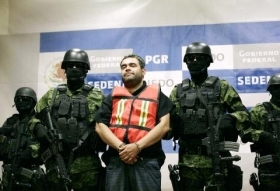Since his arrest, Tijuana Cartel lieutenant “El Ruedas” has handed over a treasure trove of information about the group’s operations and relationship with the Sinaloa Cartel.
New Tijuana police chief Alberto Capella Ibarra called a meeting with press and business leaders shortly after Juan Francisco Sillas Rocha, alias “El Ruedas,” was arrested. He announced that, according to the criminal boss, Capella had broken longstanding agreements between the police and criminal groups. As El Mexicano reports, Capella claimed Sillas said “Things changed when you arrived, you broke the agreements.” The implications of this, if true, are serious.
It is not the first time that claims have surfaced about the existence of pacts between the police and the AFO. Julian Leyzaola took over the Tijuana Police Department in 2010, at the height of the war between cells loyal to Eduardo Teodoro Garcia Simental, “El Teo,” and those loyal to Fernando Sanchez Arellano, “El Ingeniero.” It was widely speculated that he cut a deal with the AFO forces loyal to Sanchez Arellano to wipe out the Garcia Simental cells, which were responsible for widespread kidnappings in the city. Some analysts have suggested that, with state forces separated from the drug trade, there will be no mediator to enforce agreements between criminal groups. This could result in conflict between the trafficking groups present in the plaza including the AFO, the Sinaloa Cartel and remnants of the Familia Michoacana.
In his statement to prosecutors, as reported by Zeta magazine, Sillas painted a picture of a rapidly regenerating AFO. He claimed that Sanchez Arellano, leader of the AFO, now commands 11 cells dedicated to trafficking drugs in Tijuana and abroad, up from only five during the conflict with Garcia Simental, and named cartel logistics operators who organize trafficking from Guadalajara to Cancun. This suggests that the AFO has moved from an enforcer-oriented group to a more sophisticated trafficking organization. The story of “El M4” is most illustrative of the process. El M4 led a group of assassins or enforcers who were wiped out during the conflict with Garcia Simental, but today he focuses exclusively on drug trafficking.
Sillas pointed to the AFO’s ability to maintain a firm grip on drug distribution contacts throughout California, but especially in the north of the state depite its supposedly weakened state. This fits with InSight Crime’s analyses of the situation.
Sillas also confirmed what InSight Crime has suggested about the nature of the relationship between the Tijuana Cartel (also known as the Arellano Felix Organization – AFO) and the Sinaloa Cartel, claiming that the two work side-by-side in the Tijuana plaza without violence. He said that the trafficking networks are autonomous, but have come to a non-aggression pact.
The AFO also has an advantage in any competition with the Sinaloa Cartel in the Tijuana plaza; unity. The Sinaloa cells in Tijuana operate independently and sometimes in competition with each other, according to the statements of “El Tomate,” a Sinaloa Cartel recruit and former Garcia Simental lieutenant. The Sinaloa Cartel learned a lesson about compartmentalizing operations following the defection of some of their chief trafficking and intelligence lieutenants to the Beltran Leyva Organization (BLO) in 2008. The bloody struggle between the BLO and the Sinaloa Cartel seemingly left a deep impression upon Joaquin Guzman, “El Chapo,” and Ismael Zambada Garcia, alias “El Mayo.” Since then, the Sinaloa Cartel has reportedly maintained cells in Tijuana that operate peacefully, but in competition with each other, to prevent the total loss of the plaza. This means that while the AFO may not be as large, or even as profitable as the Sinaloa cells in the area, they have the advantage of unity.
Ruedas also gave an insight into the inner workings of the AFO following a chaotic period. He described lieutenants like “El Turbo” who switched back and forth the between the AFO and Garcia groups until settling with the surviving AFO. He acknowledged the strength of Sinaloa lieutenants in Tijuana like “La Rana” and “El Aquiles” but, again, portrayed the AFO as stronger than most analysts have previously believed.
The AFO has become a low-profile trafficking organization since its internecine conflict, which ended in 2010. It has proven capable of regenerating rapidly, but if the statements of police chief Capella are to be believed it has lost its relationship with the municipal police. The Sinaloa Cartel, which is in conflict with the BLO, the Juarez Cartel and the Zetas throughout the country, appears keen to minimize problems in Tijuana. By the time the Sinaloa Cartel is done with those conflicts the AFO may be a fully regenerated cartel.
*Nathan Jones is a Post-Doctoral Fellow at the Baker Institute of Public Policy focusing on drug policy.

